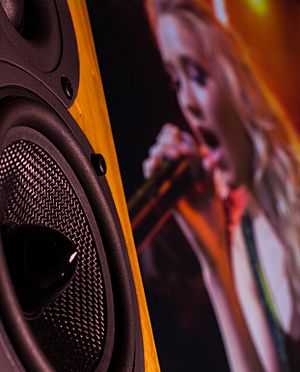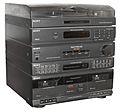High fidelity facts for kids
High fidelity, or hi-fi, is a term for a really good home music system. It means the sound you hear is super close to the original sound. There are no extra noises or changes. People who love hi-fi are sometimes called audiophiles. Today, hi-fi is often known as "high-end audio."
Contents
History of Hi-Fi Sound
In the 1930s and 1940s, vacuum tubes were used to build radios. They also made electronic amplifiers. Radios were becoming very popular back then. Companies started selling microphones, amplifiers, and loudspeakers.
Manufacturers wanted to make the best products. A lot of new ideas came from Bell Laboratories. Companies like Western Electric made many of these early sound products.
How Hi-Fi Became Popular
Later, a new type of vinyl record was invented. These records had less noise and much better sound. To help sell their new products, companies started calling their equipment and records "high fidelity."
In the 1950s, "hi-fi" became a very popular word. It replaced older terms like "phonograph" and "record player." Instead of saying they played a record "on the phonograph," people would say they played it "on the hi-fi."
Stereo Sound Arrives
In the late 1950s and early 1960s, a company called Westrex created the stereo record. This new record used two speakers instead of one. This invention led to even more improvements in home audio systems.
Soon, the word "stereo" became more common than "hi-fi." People started saying they played records "on a stereo." Even today, "high fidelity" is still used for very high-quality music systems. Some people buy separate parts for their systems. They might even build their own equipment to get the best sound.
Images for kids
See also
 In Spanish: Alta fidelidad para niños
In Spanish: Alta fidelidad para niños




